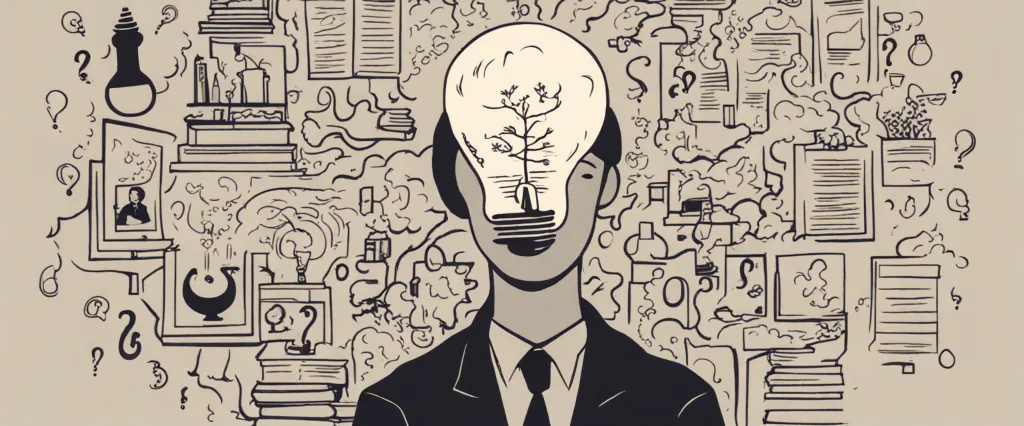In his groundbreaking book, “Make it Stick” Peter C. Brown explores the true nature of how we learn and provides evidence-based techniques to enhance our ability to retain information effectively. As a writer, researcher, and speaker, Brown has dedicated his career to understanding the intricacies of learning and translating his findings into actionable strategies. This enlightening work challenges conventional wisdom about traditional study methods and reveals the secrets to long-term memory retention. It is a must-read for anyone seeking to improve their learning capabilities and maximize their educational experience.”
Learning vs. Illusion
The authors argue that many traditional study practices, such as rereading and highlighting, are ineffective for long-term retention. Instead, they propose more effective strategies, such as retrieval practice and spaced repetition, that challenge the learner to actively recall information from memory. Retrieval practice involves self-testing and quizzing oneself on the material being studied, while spaced repetition involves revisiting and reviewing information at increasingly spaced intervals.
The book also emphasizes the importance of interleaving different topics or skills during practice, rather than focusing on one subject at a time. Interleaving helps to create connections between related concepts, enhancing understanding and retention. Additionally, the authors highlight the benefits of embracing difficulties and making mistakes during the learning process. When learners encounter challenges, struggle, and actively try to overcome them, they create stronger neural connections, leading to better long-term learning.
“Make it Stick” is filled with examples and case studies that demonstrate the effectiveness of these strategies. It also provides practical tips and advice on how to implement these methods in various learning environments, such as classrooms and workplace training.
By debunking myths and offering practical strategies, “Make it Stick” empowers readers to become more efficient and effective learners.
Embracing Difficulties
One of the important concepts explored in the book is the idea of embracing difficulties as an essential part of the learning process.
According to Brown, the human brain has a tendency to forget information if it is not actively engaged in retrieving and reviewing that information. However, highlighting this information or re-reading it does not guarantee long-term retention. Instead, the book suggests that difficulties encountered during the learning process actually strengthen the brain’s ability to retain information.
By actively grappling with challenging concepts and practicing the process of retrieving learned information, learners create stronger neural connections, enabling better recall and application of knowledge. The authors argue that the struggle and “desirable difficulties” during learning situations lead to more durable learning. Moreover, they emphasize the importance of spaced repetition, or revisiting information at intervals over time, as a way to reinforce memory.
To embrace difficulties, the book recommends a range of techniques, such as taking practice tests, summarizing information in one’s own words, and spacing out study sessions. The authors also emphasize the benefits of interleaving, which involves studying and practicing different topics or skills in a mixed, varied manner instead of focusing on just one area at a time.
By embracing difficulties and employing these strategies, learners can enhance their ability to learn, remember, and apply information effectively. The book offers valuable insights into how to make learning stick for the long term and achieve better academic and professional success.
Spacing and Interleaving
Spacing refers to the practice of distributing learning sessions over time, instead of cramming all the studying into one session. Research has consistently shown that spacing out learning sessions and revisiting the material at regular intervals improves long-term retention. The brain benefits from the effort it takes to retrieve information from memory, as this stimulates more connections and strengthens neural pathways. Regularly reviewing the material in spaced out intervals reinforces learning and prevents forgetting.
Interleaving, on the other hand, involves mixing and alternating different topics or concepts during study sessions. Instead of focusing on a single topic for an extended period, interleaving provides students with a variety of related or unrelated topics in a study session. This practice challenges the brain to make connections and recognize patterns across different contexts, helping improve understanding and transferability of knowledge. In addition, interleaving forces learners to retrieve information from memory more frequently, which enhances long-term retention.
Both spacing and interleaving strategies are supported by cognitive psychology research on how the brain learns best. The book emphasizes that these strategies may feel counterintuitive or more difficult initially because they require more effort and the occasional struggle with retrieval. However, the effort put into spacing and interleaving pays off in the long run with improved retention and mastery of the material.
By implementing these strategies, learners can enhance their understanding, remember information for longer periods, and improve their ability to apply knowledge in various contexts.
Retrieval Practice

The authors argue that the conventional methods of learning, such as rereading and highlighting, can create an illusion of mastery but fail to establish true understanding.
Retrieval Practice involves putting aside the materials and attempting to retrieve information from memory. This mental effort strengthens memory retrieval pathways and helps in building durable learning. It is more effective than simply reviewing the material because it compels learners to actively reconstruct their understanding and retrieve information, which enhances learning and long-term retention.
The book suggests several ways to incorporate Retrieval Practice into learning. Frequent low-stakes quizzes or self-testing, either in written or verbal format, help learners reinforce and consolidate what they have learned. Flashcards or practice tests that challenge recall rather than recognition are also recommended, as they improve memory by forcing learners to actively retrieve information.
The authors propose that interleaving various topics or skills during practice, rather than blocking them together, furthers the benefits of retrieval practice. This method facilitates comparison and contrast, making concepts more distinct and memorable, which enhances long-term learning.
The importance of feedback is another critical aspect emphasized in Retrieval Practice. Immediate feedback helps learners identify errors or misconceptions, leading to corrective actions. It is vital for learners to engage with their mistakes and confront their own misunderstandings to achieve better long-term retention and understanding.
In summary, incorporating frequent self-quizzing, practice tests, interleaving topics, and providing immediate feedback are all strategies suggested in the book ‘Make It Stick’ to optimize retrieval practice and enhance learning outcomes.
Elaboration and Generation
Make It Stick: The Science of Successful Learning, written by Peter C. Brown, Henry L. Roediger III, and Mark A. McDaniel, examines effective learning strategies based on cognitive psychology research. The book highlights two essential techniques: elaboration and generation.
Elaboration involves connecting new information to existing knowledge. The authors emphasize the importance of actively seeking to understand and make sense of new material, rather than simply passively reviewing it. Elaboration enables learners to form meaningful connections and create mental frameworks that help retain and recall information. One strategy is to explain concepts to yourself or others, forcing you to clarify your understanding.
Generation involves actively recalling and retrieving information without relying on external cues. This practice strengthens long-term memory and promotes true comprehension. Engaging in self-quizzing or answering questions about the material improves retention. Additionally, interleaving topics by frequently switching between different subjects during study sessions enhances learning by promoting cognitive flexibility and preventing context-dependent learning.
The book highlights the inefficiency of conventional study techniques, such as rereading and highlighting, which may create an illusion of mastery without significant gains in knowledge retention. Instead, the authors advocate for spaced learning, where reviewing information is spaced out over time, and varied practice, which involves practicing multiple related skills in a mixed order rather than focusing on one at a time.
Make It Stick emphasizes the power of retrieval practice, active engagement, and embracing difficulties during the learning process. The authors provide practical recommendations for educators and learners to optimize their study habits and improve learning outcomes based on scientific evidence. By implementing elaboration and generation techniques, individuals can enhance their knowledge retention, comprehension, and overall learning success.
Reflection and Metacognition
Reflection, as presented in the book, involves taking the time to review and analyze our learning experiences. This includes thinking critically about what we have learned, why it is important, and how it connects to other knowledge or experiences. According to the author, this process of reflecting helps us consolidate our learning, make it memorable, and transfer it to new situations. By engaging in reflection, learners become more aware of their own thinking processes and can identify areas of weakness or gaps in their understanding.
Metacognition, on the other hand, refers to the ability to think about and regulate our own thinking processes. The book highlights the importance of metacognitive practices such as self-testing, spacing out practice sessions, and interleaving different topics or skills. These strategies challenge learners to retrieve information from memory rather than simply re-reading or reviewing materials. By testing their own knowledge and spacing out their practice over time, learners strengthen their ability to recall information and develop robust mental frameworks.
Through a series of research-backed examples and practical advice, Make it Stick argues that traditional study methods like cramming and highlighting are less effective in promoting durable learning. Reflection and metacognition, the book suggests, are key ingredients in effective learning, as they help learners develop a deeper understanding of the material and enhance their ability to apply knowledge in real-world scenarios. By utilizing these strategies, readers can optimize their learning experience and improve their long-term retention and application of knowledge.
Applying Learning in Real-World Contexts
Brown argues that traditional learning techniques, such as rote memorization or cramming, may lead to short-term performance but fail to promote true learning and retention.
Brown suggests that in order to make learning stick, learners should actively engage with the material and intentionally practice retrieving the information from memory. The concept of retrieval practice involves recalling information from memory instead of merely reviewing or rereading it. This practice helps in reinforcing neural connections, strengthening learning, and enhancing long-term memory.
Additionally, the author highlights the importance of interleaving different topics or skills when learning. Rather than studying a single topic intensively, interleaving involves the deliberate mixing of different subjects, which can improve comprehension and transfer of knowledge to different contexts.
To bridge the gap between classroom learning and real-world application, Brown proposes the use of realistic scenarios and examples that mirror authentic situations. By incorporating real-life contexts, learners are more likely to grasp and retain information, as the material becomes relevant and meaningful. This approach helps individuals transfer knowledge from the classroom to practical situations successfully.
Furthermore, Brown emphasizes the significance of spacing out learning sessions over time, known as spaced repetition. Distributing practice sessions allows for better long-term retention compared to cramming. Similarly, the book stresses the importance of reflection and feedback to reinforce learning and identify areas for improvement.
By adopting these techniques, learners can transform their approach to studying and significantly enhance knowledge acquisition, information retention, and real-world application.

Cultivating a Learning Culture
The book challenges conventional wisdom about how we learn and provides evidence-based techniques to improve retention and application of knowledge.
One of the core principles discussed in the book is the concept of “desirable difficulties.” Brown argues that learning is most effective when it involves a degree of challenge and effort. Instead of simply reviewing and re-reading material, learners should engage in active retrieval practices, such as quizzes or self-testing. These methods enable learners to build stronger neural connections and improve long-term memory retention.
Another key idea is the importance of spaced practice. Instead of cramming information into a single session, learners should distribute their practice over time. This helps reinforce memory retrieval and prevents forgetting. Interleaving is also encouraged, where learners mix up different topics or types of problems instead of focusing on one at a time. This technique enhances the ability to transfer knowledge and apply it to diverse situations.
Furthermore, the book emphasizes the significance of reflection and metacognition. Learners who analyze their thinking process, identify weak areas, and actively seek feedback are more likely to develop deeper understanding and improve their learning outcomes. Brown also highlights the power of using stories and making connections to existing knowledge as effective ways to enhance learning.
Incorporating desirable difficulties, spaced practice, interleaving, reflection, and metacognition will help learners not only retain knowledge but also apply it effectively in various contexts.
After Reading
In conclusion, Make it Stick by Peter C. Brown introduces readers to a wealth of research-backed strategies on effective learning and retention. The book challenges conventional study methods and offers a fresh perspective on effective learning techniques. It emphasizes the importance of actively engaging with material, spacing out practice sessions, and embracing difficulties to promote deep learning. By emphasizing the role of retrieval practice, interleaving, and elaboration, Brown highlights practical strategies that can be applied by learners of all ages and fields. Ultimately, Make it Stick serves as a valuable guide for anyone seeking to enhance their learning abilities and achieve long-term retention of knowledge.
Title: Book Recommendation – Unleashing Your Personal Potential
1. Stop Walking on Eggshells” by Paul T. Mason and Randi Kreger:
This enlightening book provides essential guidance for those dealing with individuals suffering from borderline personality disorder. It offers practical strategies to manage relationships and communication, empowering readers to build healthy boundaries and foster positive connections.
2. The Four Agreements” by Don Miguel Ruiz:
Ruiz shares invaluable wisdom through four simple yet profound agreements that can transform our lives. This book explores ideas such as being impeccable with our word, not taking things personally, never making assumptions, and always doing our best. It encourages embracing these guiding principles to achieve personal freedom and true happiness.
3. Social Intelligence” by Daniel Goleman:
Building on the concepts of emotional intelligence, Goleman explores how our social interactions impact our overall well-being. From empathy and understanding emotions to effective communication and developing positive relationships, this book delves into the crucial skill set of social intelligence and its profound impact on our personal and professional lives.
4. Mindset: The New Psychology of Success” by Carol S. Dweck:
Dweck’s groundbreaking book challenges our preconceived notions about intelligence and learning. She introduces the concept of a growth mindset and demonstrates how possessing this mindset can unlock our potential for continuous growth and achievement.
5. The Power of Habit” by Charles Duhigg:
This captivating exploration of habit formation and change reveals the science behind our routines, both good and bad. Duhigg provides compelling insights into how habits shape our lives and offers practical strategies to break free from undesirable patterns and cultivate new, empowering habits.
These five books, including “Stop Walking on Eggshells,” “The Four Agreements,” and “Social Intelligence,” offer a diverse range of knowledge and perspectives on self-improvement, interpersonal relationships, and personal growth. They provide practical advice, foster self-awareness, and empower individuals to unleash their full potential.




